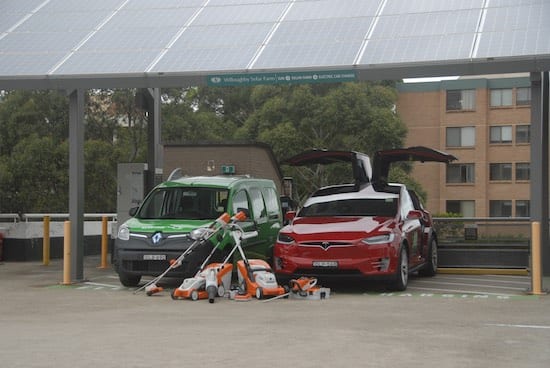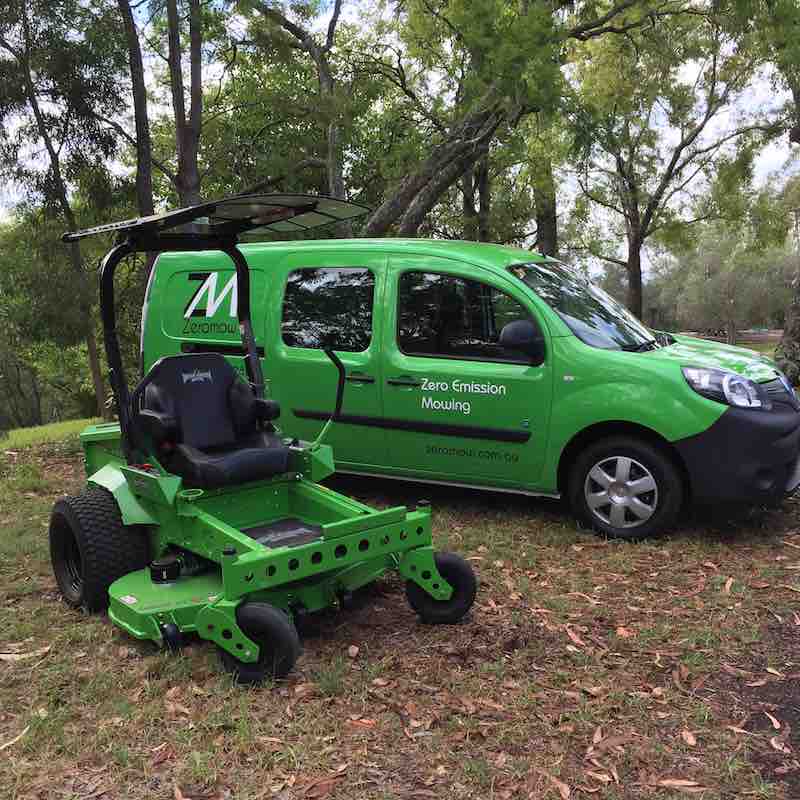Australians love their power tools. The proliferation of Bunnings Warehouses, the ever present suburban hum of leaf-blowers and lawn-mowers, and row upon row of obsessively manicured nature strips all bear testimony to that fact. And, like our cars, we seem to like them petrol powered.
But, just like with cars, this does not have to be the case. Just like with cars, there are fully electric, lithium-ion battery powered and cordless alternatives that – although a little more expensive to buy at the outset – do the same job, but with less pollution, less noise, and much lower ongoing maintenance and refuelling costs.

Consider this statistic from a federal government department of environment fact sheet: “A two-stroke leaf blower used for one hour can produce as much hydrocarbons as 150 cars over the same time.”
And, just like with cars, hardly anyone is promoting low emission alternatives – lack of demand means some of them are still only available overseas – and there is absolutely no government incentive to switch from petrol fuelled lawn mowers, edge trimmers, whipper snippers or leaf blowers to the much lower emission electric models.
Sally Perini is working to change this. Perini, who lives in NSW, got her first electric car in 2012. Keen to “walk the talk” of her environmental convictions and extensive philanthropic work, she swapped out her old Subaru for a fully electric Nissan Leaf.
Five years and three more electric vehicles later – a Renault Kangoo and two Teslas (Model S and X) have been added to the fleet – Perini wants to educate other Australians, politicians included, on the benefits of quitting petrol fuelled engines. And not just in cars.
At her home in the foothills of the Blue Mountains, Perini has set up a not-for-profit business, Zeromow, which offers landscape gardeners the chance to trial Perini’s own battery powered garden tools – including a fully electric ride-on mower she had shipped from the US – for free. The tools’ batteries are charged by her own rooftop solar system, or another source of green power.
Her belief is that if people could only experience using electric power tools, they would be instantly converted, in the same way Perini herself was converted to electric cars.
“When I first got an electric car, I guess I wanted to walk the talk,” Perini told One Step Off The Grid. “I was trying to make the house more energy efficient. I had solar on the roof. So I bought the Leaf.
“Up to then I had absolutely no interest in cars whatsoever. I saw them as a means to get from A to B. But I hated driving. Hated the whole experience of it.
“The moment I got the Leaf, that all changed. The convenience, savings on fuel and maintenance; acceleration. It handled better with the batteries at the bottom, with the regenerative breaking.
“It was that convenience of being able to get home, plug the car in, and the next day you leave home with a fully charged car.”
As it happened, Perini’s new-found love of EV driving coincided with first chance for Australian consumers to put a deposit down for the Tesla Model S. “So I did that.”
What really appealed to Perini about the Tesla, she said, was that it was obvious the company had the vision that went with the car: 100 per cent electric transport powered by renewable energy.
And there was another added benefit of driving one around on Australian roads. It got peoples’ attention.
“People were winding down the window asking what kind of car was that. You get the opportunity to talk to people you’d never normally reach,” Perini said.
“If everybody could have that experience, if you could talk to people, and give them a drive… it’s a lack of awareness that’s stopping (electric cars) from taking off.”
And the same goes for electric power tools, which, like their auto counterparts, have no government incentives to encourage their uptake, despite petrol fuelled equipment ranking relatively high on emissions.
According to the federal government’s own Department of the Environment fact sheet, non-road spark ignition engines and equipment (NRSIEE) – including mowers, chainsaws, leaf blowers and outboard motors – contribute significantly to air pollution in Australia, particularly in urban areas.
This is largely because these engines don’t have the same advanced emission controls found in on-road engines, so they are high polluters relative to their engine size and usage.
“For example,” says the government fact sheet, “a two-stroke leaf blower used for one hour can produce as much hydrocarbons as 150 cars over the same time.”
For this reason, high-emitting NRSIEE are banned in overseas markets like the USA, Canada, Europe and China. The Australian government says it is working towards introducing emission standards for NRSIEE.
“It’s another thing the government’s been saying they’re going to do something. But at the moment there’s no regulation over all this outdoor equipment,” Perini says.
“They give all this information on the website… meanwhile you’ve got no incentive to help people become aware there are viable alternatives, that can be powered by renewable energy.”
When Perini switched all her own power tools to electric – mostly using the well established brand Stihl – it gave her the idea to set up the zero emissions mowing business, to help create awareness and get the alternatives out there. And this is where the Renault Kangoo ZE electric van came in.
“I got the idea that I could be electric from vehicle to equipment,” she said. “And then I decided if I really wanted to create awareness … and fast-track that transition, it would be better to get the equipment out to (other gardening businesses) so they could try it themselves.
“I am lending out for free to any landscape or mowing contractor, to let them try out the equipment for a few days on the job. We can also go and demonstrate to them.”
If nothing else, she says, it starts the conversation: How much? What happens if the battery runs out mid-job? Can they do the same kind of work as fuel powered machines? How long do they take to recharge?
Like with EVs, she says, there might be more of an upfront cost with the power tools, because you have to invest in the lithium-ion batteries.
But then there’s the fuel saving, and the current range of batteries (lithium-ion) are so much better, last a lot longer per charge, and are getting cheaper. And they can be shared among the various tools.
And there are health benefits, too. The battery powered equipment is lighter to use, says Perini, and with some models of blowers, for example, you can get a backpack battery, so you’ve got so much less weight in the blower – and are not inhaling all those toxic fumes.
“The health impacts alone should be enough to make contractors think about it,” says Perini.
On the EV front, Perini has now added Tesla’s Model X to her quiver, which she says is largely used to tow the trailer that carries her fully electric commercial grade ride on mower, that she brought over from the US.
“That can get up to seven hours running time on a single charge,” Perini says. “I brought it over with hope that I would be able to get some interest on importing them.
“If I can at least create awareness that this kind of machine exists, not here, but overseas, it’s a start.
“Zeromow is working towards creating awareness. Everything is electric and all powered by renewable energy, either the solar on my roof or green power.”
As for the Model X, Perini says that gets even more attention than the Model S did. And with the company’s signage on the side of the car, it’s all working towards creating that zero emissions awareness she’s aiming for.
This article was originally published on RenewEconomy’s sister site, One Step Off The Grid, which focuses on customer experience with distributed generation. To sign up to One Step’s free weekly newsletter, please click here.










